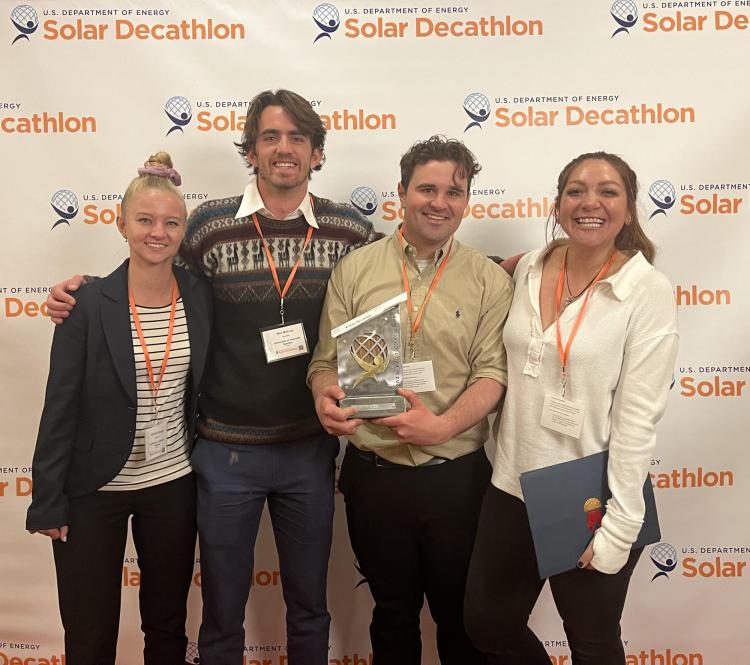CU Boulder team takes top engineering prize in 2023 Solar Decathlon with community housing project

An affordable, net-zero energy home designed by CU Boulder students was honored Sunday as part of the U.S. Department of Energy’s 2023 Solar Decathlon Build Challenge. The home — which is still being constructed and features a unique hydrogen energy system — is part of a partnership between the university, Flatirons Habitat for Humanity and the City of Boulder as part of the ongoing Ponderosa Community Stabilization Project.
The CU Boulder team took first place in the durability and resilience category and third place in the engineering category on the project, which will build a low-carbon footprint home out of sustainable materials in Boulder this summer. The team was also recognized in the Advanced Technology category.
This is the university’s fifth time participating in the Solar Decathlon, and the 2023 entry features a first-of-its-kind residential energy system that produces, stores and uses green hydrogen power in addition to other sustainable technologies. When finished this fall, the home will serve as an anchor for the re-developed Ponderosa Community, which was damaged by catastrophic flooding in 2013 and is being rebuilt into an affordable, energy-efficient community north of Boulder.
Co-Project Lead Weston McEvoy said the effort features work by students from the College of Engineering and Applied Science, as well as the Program in Environmental Design and others. He said about 15 students worked on the design of the home — known as The Canopy — this year, while about 20 others will work with volunteers from Habitat for Humanity to physically build it in the coming months.
“The recognition from the competition is great, and now we are looking forward to getting out there and actually building this amazing home for not only the future owners but also for the community around it, which can use our work as a model for sustainability and efficient building practices going forward,” said McEvoy, who is a junior in the Department of Electrical, Computer and Energy Engineering.
Almost every aspect of the single-family home is designed with carbon emissions and sustainability in mind. High-quality materials like insulation were selected not only for their ability to improve heating and cooling efficiency but also because they would last for decades. These materials also lowered the amount of embodied carbon emissions from construction.
Combine those efforts with smart home technology for better owner control, solar panels to capture energy from Colorado’s ever-present sun and a thermal battery that provides on-demand domestic hot water, and you have a structure that is incredibly self-sufficient, practical and resilient in the face of natural disasters and climate change.
- Heather Walker, mechanical engineering
- Kira Goo, mechanical engineering
- Grace Ohlsen, computer science
- Kate MacKeigan, architectural engineering
- Crystal Gonzalez, architectural engineering
- Charlotte Russell, architectural engineering
- Nicholas Arvidson, environmental design
- Wes McEvoy, electrical, computer, and energy engineering
- Jarod Concha, civil engineering (MS)
- Rachel Fenn, architectural engineering (MS)
- Kyle Biega, architectural engineering (MS)
- Paul Neumann, architectural engineering (MS)
- Kyle Biega, graduate advisor
- Jay Arehart, faculty lead
- Jennifer Scheib, faculty advisor
The Canopy will also be Colorado's first grid-connected hydrogen-powered home. This means that during the day, solar panels will produce electricity for the home’s needs with excess power directed to an electrolyzer that converts water into hydrogen. That hydrogen can be safely stored for five to 10 days before being used to power the home at night or in the case of a power grid failure. Excess power from the solar panels can also be sent back to the grid to offset the fossil fuels being used.
Paul Neumann is a graduate student in the Department of Civil, Environmental and Architectural Engineering and serves as a project co-lead and engineering lead. He said that too often discussions about ways to reduce carbon emissions focused on personal vehicles rather than the homes where people spend a huge portion of their lives.
“This home can operate inside and outside of the grid with the hydrogen system, and there is no need for intensive lithium ion batteries,” he said. “That means the home will save 4.5 metric tons of carbon dioxide by being energy independent each year. That is the equivalent of getting a 24 mpg gas car off the road.”
Neumann added that the project was a unique and potentially powerful experience for students on the team as it combines engineering principles, hands-on building activity and cross-community engagement around climate change.
“We have talked to so many students from different backgrounds about this project and they are all so interested in ways they can become involved,” he said. “A lot of them want to do something around climate change. This kind of work is a great venue for that no matter your specific discipline or where you are at with your education.”
Framing and early construction activity on the home is ongoing, and the team hopes to finish and publicly showcase their work in fall 2023. McEvoy said the project aims to ultimately demonstrate the balance between affordability and innovation needed for the next 10 years of construction in Colorado and beyond.
“Our goal is to show that net-zero, sustainable housing can be affordable,” McEvoy said. “Our project shows how we can increase the lifespan of the home while also lowering energy and repair costs to the owner through these newly applied systems.”

